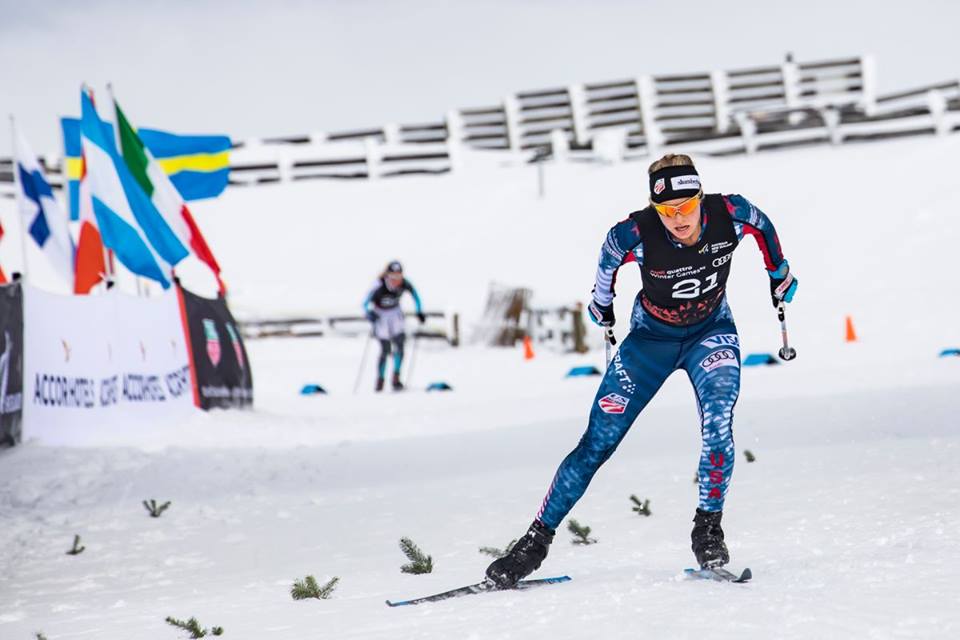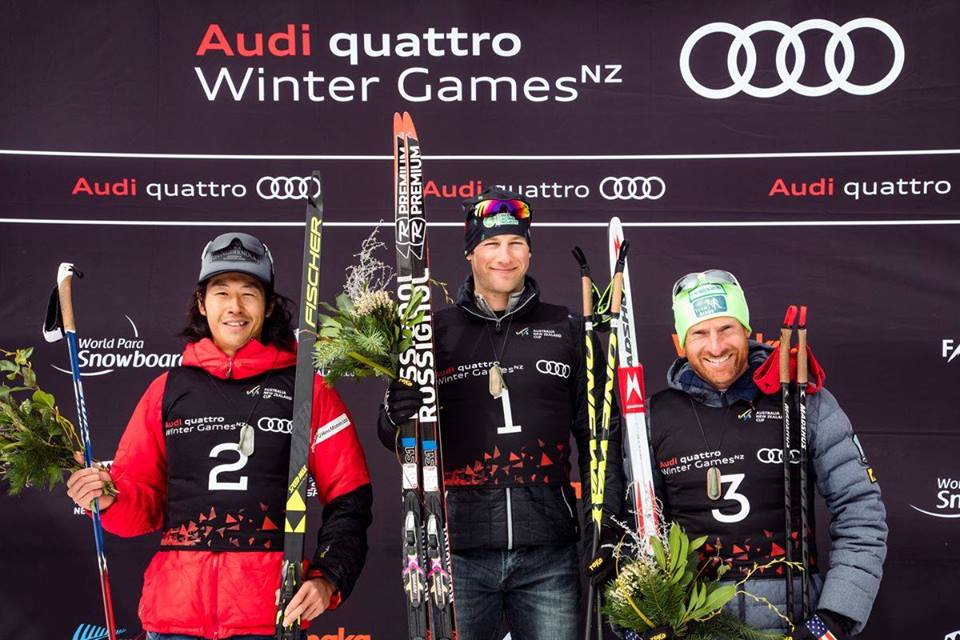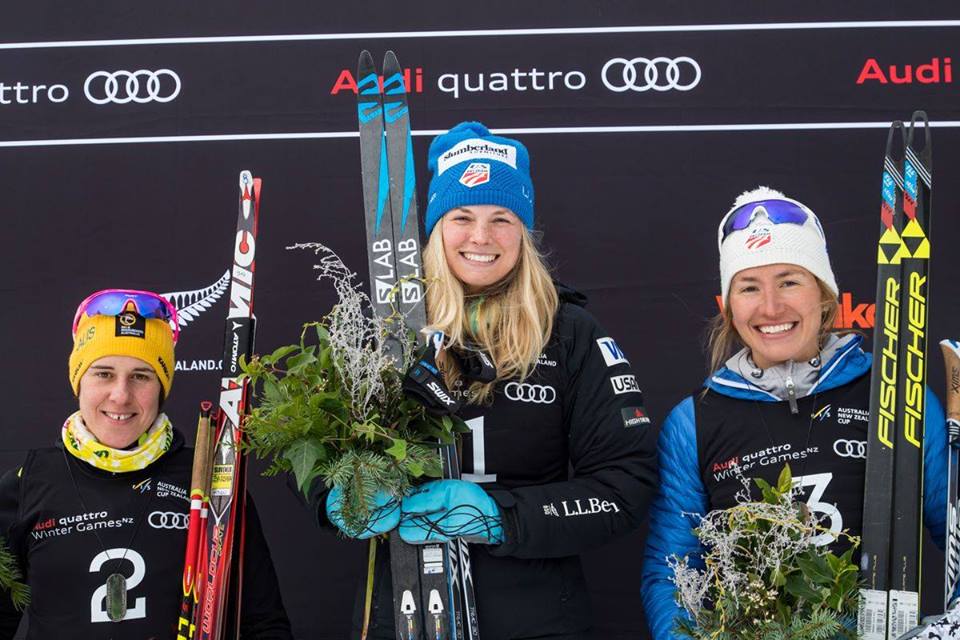
What if getting to snow-covered groomed trails came in three steps — those literally being from the front door to the trailhead. While recent winters may make this seem like a melting dream for many, a number of Americans made it their reality these past two weeks while staying at the Snow Farm in Wanaka, New Zealand.
U.S. Ski Team (USST) members, as well as American skiers representing the Craftsbury Green Racing Project (CGRP), Sun Valley Ski Education Foundation (SVSEF), Stratton Mountain School (SMS), and Team Gregg, flew more than 24 hours to take full advantage of the Snow Farm’s accommodations and 55 kilometers of groomed track for several weeks in late August/early September. While each program held its own respective training camp, the coinciding times made for an American medley of skiers on the farm. Jessie Diggins, Sophie Caldwell, Ida Sargent, Simi Hamilton, and development-team member Julia Kern all made the trip for the USST’s camp, which ran from Aug. 22 to Sept. 11.
According to USST Women’s Coach Matt Whitcomb, the New Zealand camp is not mandatory for all team members.
“Being an Olympic year we want to individually tailor each plan [for each athlete],” he explained in an email.
Liz Stephen and Kikkan Randall opted to train in Sweden with the Swedish national team earlier this summer, and Andy Newell prioritized summer rollerski racing in Norway.
“The travel didn’t make sense to do both,” Whitcomb continued. “For snow, Kikkan has glacier time in Alaska and Liz will do Foret Montmorency in early November. The same was true for Andy … [who] wanted to try Norway instead of New Zealand. While Kikkan has come down to the Southern Hemisphere with us, it makes sense for the Alaskans [including Sadie Bjornsen, Erik Bjornsen, Scott Patterson, Rosie Brennan, and Hannah Halvorsen, who train with Randall with Alaska Pacific University] to use the excellent facility on Eagle Glacier.”
For those that made this year’s New Zealand trip, he said it’s certainly worth it.
“While the trip to New Zealand means airfare that can cost around $1200-1300, the Snow Farm cooks exceptional food, grooms around 30k daily, and provides cozy lodging,” Whitcomb wrote.
“We had a strong group of Americans at the Snow Farm this year, which made for entertaining dinners and competitive ping pong matches,” he continued. “[SVSEF head coach] Chris Mallory is very good. We partnered up with Craftsbury Green Racing Project, SMS Elite Team, and Team Gregg for a bunch of sessions, and that made for some really effective days.”
Whitcomb further explained that for those USST athletes returning to the New Zealand training camp, a few things were done differently in terms of lodging.
“We tried something new this year,” Whitcomb wrote. “We live and train at the Snow Farm, which is situated at 5,000 [feet]. This year we trained for 7 days, and then rented a house in a hip little town called Wanaka where we recovered near sea-level for two nights, and cooked our own food. I think this played an important role in most athletes having strong second and third weeks up on the rock. If week three is too much of a struggle, the training doesn’t get absorbed effectively, and it dampens the benefits of the camp.”
The opportunity to get on snow, as well as the convenience of its location with regards to lodging, were reasons enough for many non-USST members to also travel to the Southern Hemisphere.
“Not having to commute to skiing saves a lot of time and energy that we can put into training and effective recovery,” Ben Lustgarten of the CGRP wrote in an email to FasterSkier. “It is also really nice being at 5000 feet instead of 9500 feet like it would be on a glacier in Europe, and the skiing terrain here is much more conducive to a variety of workouts: intervals, specific technique work, races, easy distance, flats, hills, etc. I loved our training camp last year on the Dachstein glacier, but a 3km loop at 9000ft that takes 45 minutes to get to is really hard and doesn’t offer the variety of training that we can do here.”

Several Americans also competed in the Snow Farm’s Winter Games NZ races, which featured a men’s and women’s 1.6 k classic sprint, 5/10 k freestyle races and a 10/15 k classic mass starts, all part of the Australia/New Zealand Cup.
Some of them had already raced a Worldloppet marathon earlier in their stay, and Whitcomb explained each athlete’s race schedule in New Zealand varied depending on how they absorbed the training load. USST athletes were encouraged to do two to four races, choosing between the 42 k or 21 k Merino Muster Worldloppet and three Winter Games NZ races.
“When it goes well, we stack it high,” he wrote.
Racing kicked off on Thursday, Sept. 6, with the men’s 10 k and women’s 5 k individual starts. A light dusting of fresh snow covered the 2.5 k race loop, which challenged racers to a series of short steep uphills and two twisty downhills.
That didn’t slow Lustgarten, who won the men’s 10 k in 27 minutes, 35.5 seconds. After pacing his first two laps and slowing a bit in his third, the 25-year-old Burlington, Vt., native heard his time was not too far from the win and went for it.
“I got a split that I was 2 seconds from the lead with a lap to go, which made the last few minutes really painful, but I managed to get the win which was really exciting!” Lustgarten wrote. “I haven’t won a skate race in a really long time, so I was happy about that.”
Finishing 8.9 seconds back from Lustgarten’s time was Japan’s Kaichi Naruse in second. American Brian Gregg of Team Gregg/Loppet Nordic Racing rounded out the podium in third (+49.7). Also making the top five were Americans Adam Martin (CGRP) in fourth (+51.9) and Matt Gelso (SVSEF) in fifth (+2:02).
In the women’s 5 k, Diggins (USST/SMS Elite Team) came away with the win, covering the course in 14:53.8. Australian Barbara Jezersek followed 9.9 seconds back in second place, and Caldwell (USST/SMS Elite Team) reached the podium in third (+10.5). Rounding out the women’s top five were Caitlin Patterson (CGRP) in fourth (+34.7) and Caitlin Gregg (Team Gregg/Loppet Nordic Racing) in fifth (+42.8).

“It was phenomenal!” Diggins said, according to a U.S. Ski & Snowboard press release. “They did so well to find all those hills—I like hills—and it was impressively hard.”
Skiers returned Friday for the men’s and women’s 1.6 k classic sprints. Caldwell returned to the podium, this time in first, besting her USST teammate, Ida Sargent (USST/CGRP) in second and Patterson in third.
“It’s only September and we still have two months before we head to Europe, but it’s always nice to have some encouraging races that confirm the training is paying off,” Caldwell told U.S. Ski & Snowboard. “I’ve had a really productive camp and was happy to end it with a win in the sprint and a third in the 5k, which was probably one of my best-ever distance skate results!”
In the men’s sprint, Ben Saxton of the SMS Elite Team took the win, ahead of Lustgarten in second and Naruse in third. Saxton chose to double pole through the rounds, which were run in four heats of four, seeing the race as an opportunity to try different race tactics.
“I just love double poling, and getting a chance to stress and test that technique in a racing situation is always a valuable learning experience,” Saxton wrote in an email to FasterSkier.
“I thought the trip was a really special opportunity to work on some technical aspects of skiing that don’t totally translate from snow to asphalt,” he continued. “Additionally, the diverse crowd of skiers at the Snow Farm ensured that the quality of training stayed high for all 3 weeks which always leads to big gains.”
After using classic skis in the qualifier, Lustgarten also opted to double pole the heats, due to what he described as “slick” conditions.
“Double poling the heats was a good idea with the downhill finish, but I felt incredibly awkward on the herring bone because I was so scared I would accidentally glide using my skate boots and skate skis, so I lost a few seconds on the climb but kept within the rules,” Lustgarten wrote. “Races this early in the season are good to point out what I need to work on, and I definitely need to add herring bone to the list.
“I managed to make it to the A-Final and was right behind Saxton when he took off over the first long climb, and when he made a gap of 2 seconds or so he secured the win,” he continued. “I was happy to double pole past Japanese racer Kaichi for second place.”
Lustgarten once again returned to the podium on Saturday, Sept. 9, the third consecutive day of racing, in the men’s 15 k classic mass start. With wind blowing snow into nearly white-out conditions, Lustgarten indicated that half of the battle was simply staying on course. He and his new CGRP teammate, Martin forged to the front joined only by Naruse after lap 1 of 4.
“I had to snowplow a lot of the downhills and just look for the edges of the track,” Lustgarten wrote. “It was hard to make any moves because every downhill we hit the leader would have to slow down a bit to see where the trail was, and those following would just rest and catch up.”
Heading into his final lap, Lustgarten surged during one of the herringbone hills in an attempt to separate himself from Martin and Naruse.

“I got about 1-2 seconds on Adam and Kaichi, and realized that I had to use that gap to try and win the race,” Lustgarten wrote. “I really did not feel like I had the energy to outkick anyone, so I wanted to see if I could get a gap. I burned all of my matches on the first 75% of the last lap cresting hills hard and climbing hard and making sure to double pole really well on the flats. I was completely exhausted by the last climb but had enough of a lead to secure the win! And I was so excited to see Adam come in second!”
Lustgarten finished first in 47:50.8, while Martin crossed 23.3 seconds later in second. Naruse claimed third, 32.8 seconds back from Lustgarten.
In the women’s 10 k, Diggins won in 34:49.9, besting Patterson in second by 26.6 seconds. Sargent snagged third, 1:00.3 back from Diggins.
After returning to the U.S., USST members are currently training individually or with their clubs, Whitcomb explained. They’ll reunite Sept. 28 to Oct. 13 for a final dryland camp in Park City, Utah, where they’ll have a guest athlete from the German women’s team.
Results:
Men’s 10 k freestyle | Women’s 5 k freestyle
Men’s classic sprint | Women’s classic sprint
Men’s 15 k classic mass start | Women’s 10 k classic mass start
- 1.6 k classic sprint
- 10 k/15 k classic mass start
- 2017 Winter Games NZ
- 5 k/10 k freestyle
- Adam Martin
- ben lustgarten
- ben saxton
- Brian Gregg
- Caitlin Gregg
- Caitlin Patterson
- Craftsbury Green Racing Project
- Ida Sargent
- Jessie Diggins
- Kaichi Naruse
- Matt Gelso
- Snow Farm
- Sophie Caldwell
- Stratton Mountain School
- Sun Valley Ski Education Foundation
- team gregg
- U.S. Ski & Snowboard
- U.S. Ski Team
- wanaka
- Winter Games NZ
Gabby Naranja
Gabby Naranja considers herself a true Mainer, having grown up in the northern most part of the state playing hockey and roofing houses with her five brothers. She graduated from Bates College where she ran cross-country, track, and nordic skied. She spent this past winter in Europe and is currently in Montana enjoying all that the U.S. northwest has to offer.



